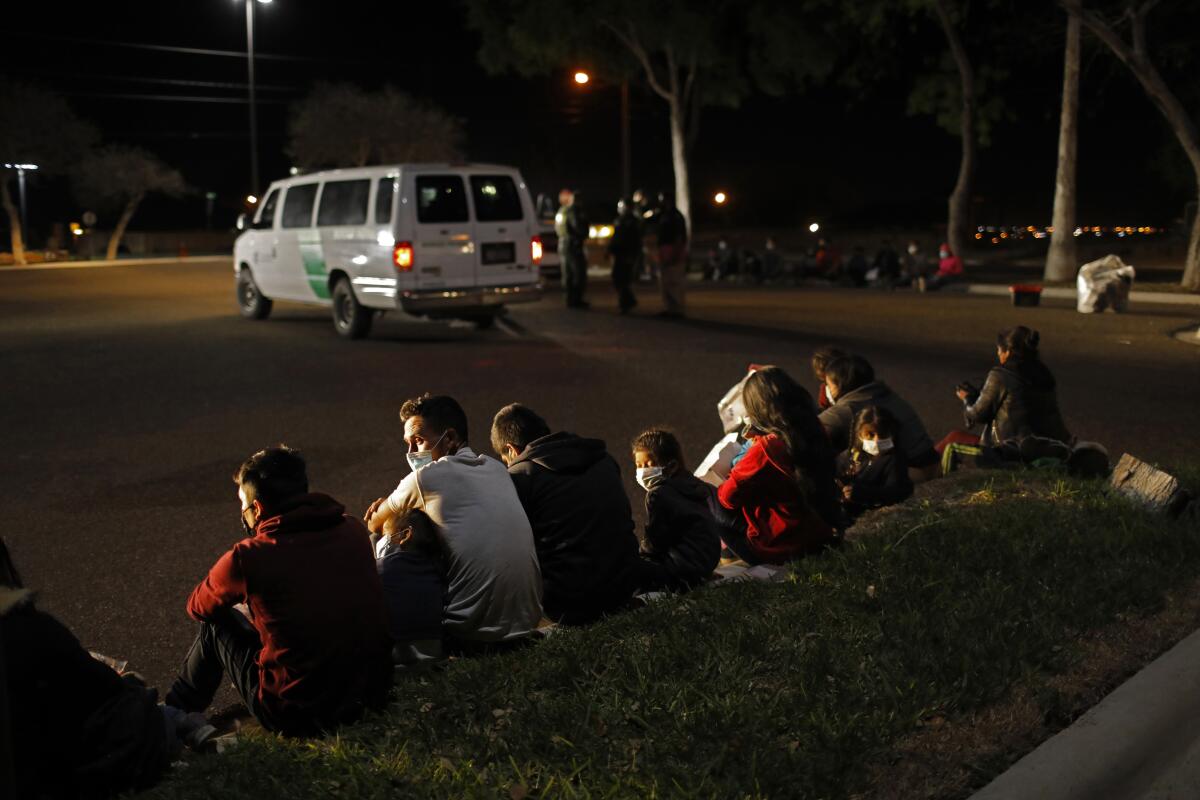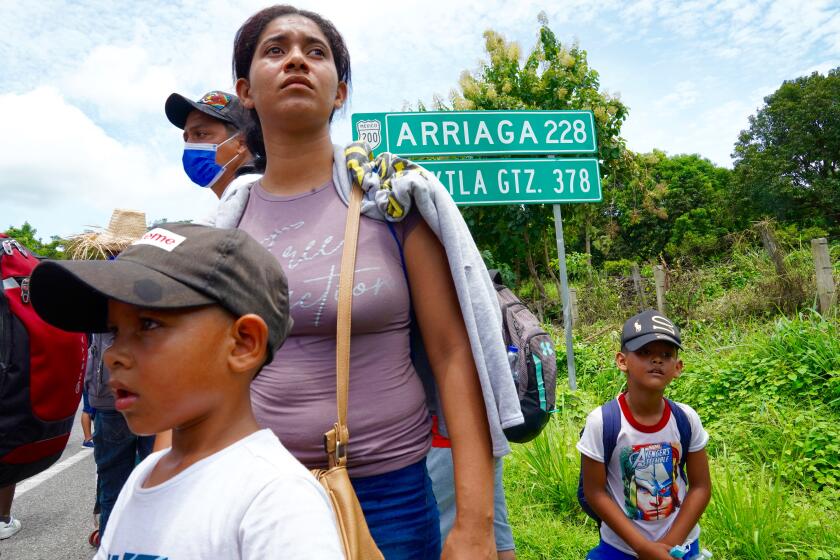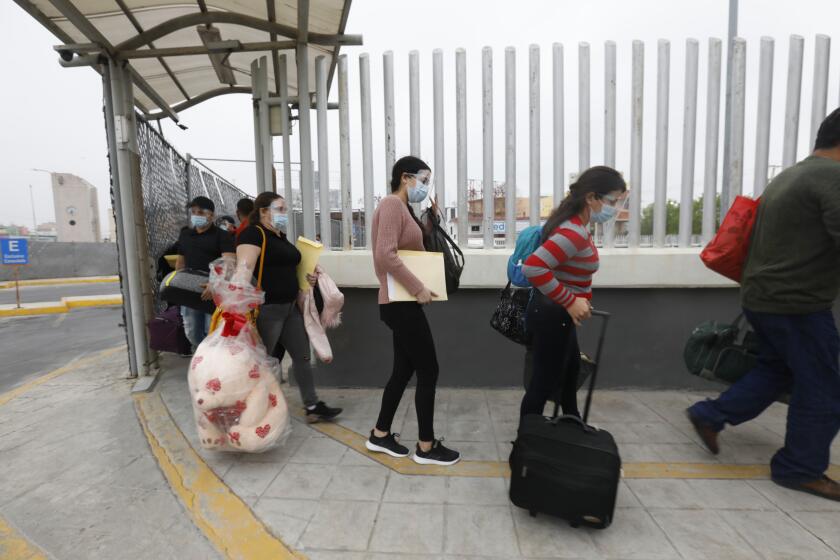Biden administration could revoke controversial border policy blocking asylum in weeks

- Share via
WASHINGTON — The Biden administration has reportedly drafted a plan to end a controversial border policy by late May that has prevented most migrants from seeking humanitarian protections at the U.S. border.
The decision by the Centers for Disease Control and Prevention is not yet final, according to people familiar with the matter, but would give officials time to prepare at the border before a change takes effect, several news organizations, including the Associated Press, reported.
Department of Homeland Security officials had been in talks for weeks over how to respond to the potential influx of asylum seekers if the policy known as Title 42 were ended. The Trump administration invoked a 1944 public health statute to quickly expel migrants either to Mexico or to their home countries, citing the need to curb the spread of COVID-19.
The CDC reassesses the need for the policy every two months and is expected to issue its latest decision this week.
Title 42 applies to adults traveling alone and to parents traveling with their children. Last year, the Biden administration exempted children traveling without a parent from being expelled under the policy.
Over the last two years, border authorities have used Title 42 to expel migrants in about 60% of encounters — more than 1.7 million expulsions — while allowing others in with humanitarian exemptions. But as the response to the pandemic changed within the U.S., officials began preparing an end to the policy.
“The fact is that after more than a year in office, this administration’s COVID policies remain deeply hypocritical: falsely scapegoating asylum seekers at the border for the spread of the pandemic while simultaneously removing COVID restrictions across the country,” said Noah Gottschalk, global policy lead for Oxfam America, which is among the groups challenging Title 42.
Earlier this month, the CDC formally ended the policy for unaccompanied children, saying their expulsion “is not warranted to protect the public health.”
Meanwhile, a federal appeals court in Washington, D.C., ruled that migrants cannot be expelled to places where they would be persecuted or tortured. That ruling has yet to take effect.
Without Title 42 in place, migrants would once again be able to seek asylum in the U.S. Before the policy was enacted, asylum seekers were screened to determine whether they could stay in the U.S. while their cases moved forward.
Title 42 is a public health policy that’s being used to determine whether immigrants can cross the border. Here’s how it works.
But officials worry that returning to pre-pandemic practices would strain resources at the border as high numbers of migrants attempt to enter. Seeking asylum is a legal right under U.S. and international law, regardless of how someone arrived on U.S. soil.
Last week, the Biden administration announced that it will overhaul the nation’s system for asylum with goals of speeding up processing at the border and alleviating immigration court backlogs. That new policy is scheduled to take effect May 28 but will initially apply only to a small number of migrants.
Before the pandemic, migrants encountered near the border were screened by agency asylum officers who assessed their claims of fear of persecution in their home countries. Those who passed the initial screening would have their cases moved to immigration court, where a judge would decide whether they qualified for asylum or another form of protection and could stay in the U.S. Meanwhile, they were detained or released pending a final court hearing that could take years.
Under the revamped asylum system and with Title 42 lifted, migrants would be allowed to make their case again, but the process would be swifter.
Immigrant advocates and some Democratic congressional leaders have ramped up efforts calling for its end. Congressional Hispanic Caucus members on Tuesday urged the Biden administration to “do the right thing.”
“It is long overdue to completely end the Trump-initiated Title 42 policy and stop using the pandemic as an excuse to keep it going,” caucus Chair Rep. Raul Ruiz (D-Coachella) said in a news release. “Transmission rates are low, there are safe testing and quarantining protocols, and vaccines are readily available.”
When Mexican officials removed a tent camp at El Chaparral plaza, many of the asylum-seekers living there ended up scattered in difficult situations around Tijuana.
Meanwhile, Republican lawmakers from Texas this week called on administration officials to keep Title 42 in place until apprehensions at the border drop to “manageable” levels.
In a March 24 letter, Democratic Sens. Kyrsten Sinema and Mark Kelly from Arizona similarly warned the Biden administration against a “premature” end to the policy.
“A sharp end to Title 42 without a comprehensive plan in motion would significantly increase the strain on DHS, border communities and local nonprofits that are already near or at capacity,” the letter states.
Homeland Security Secretary Alejandro N. Mayorkas has repeatedly punted responsibility for Title 42 to the CDC, saying it’s a matter of public health, not immigration policy. Earlier this month, though, he said the agency was planning for the possibility of its end.
Mayorkas recently met with officials in Mexico and Costa Rica to coordinate regional efforts to stem unauthorized migration. Officials are concerned about the potential for a significant increase in already high numbers of migrants arriving at the southern border and have initiated plans to increase staffing and capacity at temporary processing facilities.
Those plans include worst-case scenarios in which up to 18,000 migrants are apprehended daily, officials said on a call with reporters Tuesday on condition that they not be identified. Border officials are currently encountering an average of 7,100 migrants per day, according to a Department of Homeland Security contingency plan. Apprehensions of migrants normally increase in the spring.
For asylum seekers stuck in Tijuana waiting for the policy to change, the two-year block on requesting protection in the U.S. has meant living indefinitely in crowded migrant shelters, scrambling to pay rent for dilapidated apartments or surviving on the street in a city where they are often targeted. For nearly a year, hundreds of asylum seekers waited in a tent camp in Tijuana next to a port of entry, but Mexican officials bulldozed it in early February.
White House rolls out new system aimed at fixing asylum, a process that can drag out for years, was one of President Biden’s promises as a candidate.
As pressure mounted around Title 42, a spokesman said the Department of Homeland Security had begun requiring COVID-19 vaccines of thousands of migrants encountered at the southern border, calling it “a public health best practice.” The agency has already offered vaccines to people detained in federal immigration facilities. Vaccines are also offered to more than 1,400 people who have so far been subject to the so-called Remain in Mexico policy, under which migrants from countries other than Mexico are directed to stay there until their cases in U.S. immigration court conclude.
In deciding to vaccinate people apprehended at the border, the administration acknowledged that Title 42 is not the only way to curb the spread of COVID-19. Officials previously said the policy was necessary to protect the health of people in the U.S. and migrants themselves. But public health experts, including Anne Schuchat, the second-highest ranking official at the CDC until she departed last spring, called it scientifically baseless.
Since Biden took office, Human Rights First has recorded “at least 9,886 kidnappings, torture, rape and other violent attacks on people blocked in or expelled to Mexico due to the Title 42 policy.”
Experts say Title 42 has led to an increase in unauthorized crossings into the U.S. by people who would have otherwise requested asylum at an official port of entry. The rapid removals to Mexico also lead migrants to make repeated attempts to cross the border.
Federal officials rely on Mexico and other countries to receive migrants expelled from the U.S., which has contributed to a wide disparity among whom has been able to enter the country to seek asylum. While people from India, Turkey, Romania, Ukraine and Russia are almost never expelled under Title 42 if they reach U.S. soil, those from Mexico, Guatemala, Honduras and El Salvador are expelled most of the time, Customs and Border Patrol data show.
Those disparities became more apparent as the Biden administration began exempting Ukrainians arriving after the Russian invasion while continuing to turn away Mexicans who said they were in imminent danger in Tijuana. The move also contrasted starkly with the administration’s decision to expand expulsions to Haiti after thousands of Haitians crossed the border into Texas last fall.
Advocates say ending the use of the policy isn’t enough.
“We need to make sure it can never be used again,” said Allen Orr Jr., president of the American Immigration Lawyers Assn. “It has been focused at specific nationalities and used as a tool for border control, not public health. Certain groups have received exceptions, proving the enforcement is arbitrary. These rules cannot exist in a country where people of all nationalities should receive equal treatment.”
San Diego Union-Tribune staff writer Kate Morrissey contributed to this report.
More to Read
Sign up for Essential California
The most important California stories and recommendations in your inbox every morning.
You may occasionally receive promotional content from the Los Angeles Times.


















